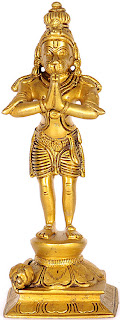When Lakshmana is severely wounded during the battle against Ravana, Hanuman is sent to fetch the Sanjivani, a powerful life-restoring herb, from Dronagiri mountain, in the Himalayas, to revive him. Ravana realises that if Lakshmana dies, a distraught Rama would probably give up, and so he dispatches the sorcerer Kalanemi to intercept Hanuman. Kalanemi, in the guise of a sage, deceives Hanuman, but Hanuman uncovers his plot with the help of an apsara, whom he rescues from her accursed state as a crocodile.
Lakshmana severely wounded in the battle
Ravana, upon learning that Kalanemi has been slain by Hanuman, summons Surya to rise before its appointed time because the physician Sushena had said that Lakshmana would perish if untreated by daybreak. Hanuman realizes the danger, however, and, becoming many times his normal size, detains the Sun God to prevent the break of day. He then resumes his search for the precious herb.
So hanuman ji asked an old lady (who couldn't walk on her own) the address of DRONAGIRI PARVAT ,as hanunam ji saw only that old lady in the village because all the men were at their farmlands & doing all their agricultural activities there.
Hanuman ji climbing the parvat in search of sanjeevani
That old lady said that she knew the address of dronagiri parvat & she cud take hanuman ji there, hanuman ji made thta old lady sit on his shoulders & reached dronagiri paravat.
But, when he finds himself unable to identify which herb it is, he lifts the entire dronagiri parvat.
Hanuman ji carrying the dronagiri parvat with his left hand.
A coin depicting this scene
Sushena then identifies and administers the herb, and Lakshmana is saved. Rama embraces Hanuman, declaring him as dear to him as his own brother. Hanuman releases Surya from his grip, and asks forgiveness, as the Sun was also his Guru.
Lakshmana back to life
A deep insight:
The portion which Hanuman dug out of the Himalayas or the dronagiri parvat was actually the right shoulder of dronagiri parvat !! & still the wounds of dronagiri parvat are alive!! it is said that dronagiri parvat is still feeling the pain of losing his right shoulder !!
The residents of dronagiri parvat area still worship & pray to dronagiri so that dronagiri parvat's pain cud be less .
Dronagiri parvat is in uttaranchal state.
People living in the village where dronagiri is situated feel themselves so lucky that they are residing under the shelter of an auspicious & holy mountain which saved the life of lakshman !!!
Still when appearance wise dronagiri looks as if a big right portion of the mountain is missing.
A part of dronagiri parvat in uttranchal
People say that still a monkey comes every year to dronagiri parvat & they all can see the arrival of monkey but no one has ever seen where monkey vanishes or goes after sometime ,it's very strange as monkeys r not at all found at the mountain area of DRONAGIRI & HIMALAYAN RANGE due to extremely cold conditions as monkeys don't like living in cold areas ,but it's strange that every year a monkey comes to dronagiri & disappears after sometime(as no one can see where that monkey goes away & what he does at dronagiri ) ,people of that village even followed that monkey but failed to know the secret.
When hanuman ji brought the dronagiri parvat to srilanka, parts from the hill fell on five places in lanka, namely rumasala in galle, dolukanda in hiripitiya, ritigala, thalladi in mannar, and kachchativu in the north.
Dolukanda in hiripitiya
Rumasala in galle
Sanjeevani Buti:
Scientists investigating what they believe is the mythical Sanjeevani herb mentioned in the epic Ramayana have discovered that it can protect living cells from the lethal effects of heat and biological stress.
Laboratory experiments have indicated that unknown substances from a herb called Selaginella bryopteriscan promote cell growth and protect them from destructive biological injuries.
Some researchers have speculated that Selaginella is Sanjeevani, used by Ram to revive his brother Lakshman injured in battle.
Sanjeevani buti
Researchers from the Madhav Institute of Technology and Sciences, Gwalior, and the Centre for DNA Fingerprinting and Diagnostics, Hyderabad, examined the effect of the herb on insect cells and on cells taken from mice.
To mimic the way the herb is used in traditional medicine, the scientists obtained the herbal extract by leaving the herb submerged overnight in an earthen pot. Then they added the extract to cells maintained in a chemical broth.
“The extract protects the cells from the harmful effects of heat, ultraviolet rays and destructive chemicals called oxidants,” said Nand Sah, professor and head of biotechnology at the Madhav Institute.
Ordinarily, living cells exposed to extreme heat, ultraviolet rays or oxidants such as hydrogen peroxide stop growing and, eventually, die. The studies on the cells carried out in Hyderabad have shown that adding the herbal extract into the mixture of cells can suppress cell death caused by ultraviolet radiation and oxidants as well as reverse heat-triggered growth arrest.
National Botanical Research Institute (NBRI) is trying to identify the gene that helps Sanjivani Booti to survive severe droughts. The plant existed before 300 million years and comes under a group of plants which were the first vascular plants on earth.
When there is no moisture the plant curls up and assumes the form of a brown crust. Sanjivani Booti regains its original form when it comes in contact with water or moisture. The plant grows in rocks and arid lands.
Jai Sri Ram





















.jpg)





























